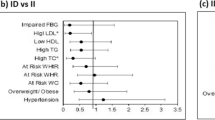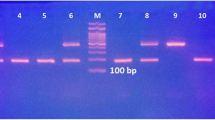Abstract
Aims: Angiotensin-converting enzyme (ACE) is a key enzyme in the production of angiotensin II, thus may participate in the modulation of cardiac growth. The aim of our study is to analyze the ACE gene I/D polymorphisms in patients with insulin resistance (IR) and to evaluate its relationship to left ventricular mass and functions. Methods: Eighteen subjects (13 female and 5 male, mean age 39.8 ± 14) with IR were enrolled in the present study. Twenty-three healthy people without IR were recruited as the control group. ACE amplification of DNA was performed by polymerase chain reaction methodology. Fasting glucose and insulin, postprandial glucose, homeostasis model assessment (HOMA-IR) and HOMA-beta, lipid profile, anthropometric measurements were assessed. Left ventricular structure and functions were measured by echocardiography. Results: Distribution of I/D polymorphism of the ACE gene in the study group was as follows: genotype II–0%, ID–38.9%, DD–61.1% of patients. Distribution of individual genotypes was similar in patients with and without IR. No significant difference was found between genotype groups in terms of anthropometric measurements and metabolic parameters and blood pressure. Echocardiography showed no significant changes in left ventricular structure and functions in patients with IR. Conclusions: We considered that in patients with IR, there is no relationship between I/D polymorphism of the ACE gene and LVH.

Similar content being viewed by others
References
Rigat B, Hubert C, Alhenc-Gelas F et al (1990) An insertion/deletion polymorphism in the angiotensin I converting gene accounting for half the variance of serum enzyme levels. J Clin Invest 86:1343–1346
Cambien F, Poirier O, Lecerf L et al (1992) Deletion polymorphism in the gene for angiotensin-converting enzyme is a potent risk factor for myocardial infarction. Nature 359:641–644
Ruiz J, Blanché H, Cohen N et al (1994) Insertion/deletion polymorphism of the angiotensin-converting enzyme gene is strongly associated with coronary heart disease in non-insulin dependent diabetes mellitus. Proc Natl Acad Sci USA 91:3662–3665
Perticone F, Maio R, Di Paola R et al (2007) Role of PC-1 and ACE genes on insulin resistance and cardiac mass in never-treated hypertensive patients. Suggestive evidence for a digenic additive modulation. Nutr Metab Cardiovasc Dis 17(3):181–187
Devereux RB, Roman MJ, Paranicas M et al (2000) Impact of diabetes on cardiac structure and function: the Strong Heart Study. Circulation 101:2271–2276
Galderisi M, Anderson KM, Wilson PW et al (1991) Echocardiographic evidence for the existence of a distinct diabetic cardiomyopathy (the Framingham Heart Study). Am J Cardiol 68:85–89
Ilercil A, Devereux RB, Roman MJ et al (2001) Relationship of impaired glucose tolerance to left ventricular structure and function: the Strong Heart Study. Am Heart J 141:992–998
Lee M, Gardin JM, Lynch JC et al (1997) Diabetes mellitus and echocardiographic left ventricular function in free-living elderly men and women: the Cardiovascular Health Study. Am Heart J 133:36–43
Colao A, Baldelli R, Marzullo P et al (2000) Systemic hypertension and impaired glucose tolerance are independently correlated to the severity of the acromegalic cardiomyopathy. J Clin Endocrinol Metab 85:193–199
Shenoy MM, Goldman JM (1987) Hypothyroid cardiomyopathy: echocardiographic documentation of reversibility. Am J Med Sci 294:1–9
Paolisso G, Galderisi M, Tagliamonte MR et al (1997) Myocardial wall thickness and left ventricular geometry in hypertensives: relationship with insulin. Am J Hypertens 10:1250–1256
Verdecchia P, Reboldi G, Schillaci G et al (1999) Circulating insulin and insulin growth factor-1 are independent determinants of left ventricular mass and geometry in essential hypertension. Circulation 100:1802–1807
Galvan AQ, Galetta F, Natali A et al (2000) Insulin resistance and hyperinsulinemia: no independent relation to left ventricular mass in humans. Circulation 102:2233–2238
Uusitupa M, Siitonen O, Pyorala K et al (1987) Relationship of blood pressure and left ventricular mass to serum insulin levels in newly diagnosed non-insulin-dependent (type 2) diabetic patients and in non-diabetic subjects. Diabetes Res 4:19–25
Palmieri V, Bella JN, Arnett DK et al (2001) Effect of type 2 diabetes mellitus on left ventricular geometry and systolic function in hypertensive subjects: Hypertension Genetic Epidemiology Network (HyperGEN) study. Circulation 103:102–107
Sundstrom J, Lind L, Nystrom N et al (2000) Left ventricular concentric remodeling rather than left ventricular hypertrophy is related to the insulin resistance syndrome in elderly men. Circulation 101:2595–2600
Matthews DR et al (1985) Homeostasis model assessment: insulin resistance and beta-cell function from fasting plasma glucose and insulin concentrations in man. Diabetologia 28:412–419
Lebovitz HE (2002) Insulin resistance and the insulin resistance syndrome. In: Clinician’s manual on insulin resistance. Science Press, London, pp 1–15
Turgut G, Turgut S, Genç O et al (2004) The angiotensin converting enzyme I/D polymorphism in Turkish athletes and sedentary controls. Acta Med 47:133–136
Sahn DJ, DeMaria A, Kisslo J, Weyman A (1978) The committee on M-mode standardization of the American Society of Echocardiography: recommendation regarding quantification in M-mode echocardiography; results of a survey of echocardiographic measurement. Circulation 58:1072–1080
European Society of Hypertension-European Society of Cardiology (2003) Guidelines committee. 2003 European society of hypertension-European society of cardiology guidelines for the management of arterial hypertension. J Hypertens 21:1011–1053
Dursunoglu D, Evrengul H, Tanriverdi H et al (2005) Angiotensin-converting enzyme polymorphism in healthy young subjects: relationship to left ventricular mass and functions. Acta Cardiol 60(2):153–158
Yang M, Qiu CC, Xu O, Xiang HD (2006) Association of angiotensin converting enzyme gene I/D polymorphism with type 2 diabetes mellitus. Biomed Environ Sci 19(4):323–327
Huang XH, Rantalaiho V, Wirta O et al (1998) Relationship of the angiotensin-converting enzyme gene polymorphism to glucose intolerance, insulin resistance, and hypertension in NIDDM. Hum Genet 102(3):372–378
Viitanen L, Pihlajamaki J, Halonen P et al (2001) Association of angiotensin converting enzyme and plasminogen activator inhibitor-1 promoter gene polymorphisms with features of the insulin resistance syndrome in patients with premature coronary heart disease. Atherosclerosis 157:57–64
Zingone A, Dominijanni A, Mele E et al (1994) Deletion polymorphism in the gene for angiotensin converting enzyme is associated with elevated fasting blood glucose levels. Hum Genet 94:207–209
Panahloo A, Andres C, Mohamed-Ali V et al (1995) The insertion allele of the ACE gene I/D polymorphism. A candidate gene for insulin resistance? Circulation 92(12):3390–3393
Katsuya T, Horiuchi M, Chen YD et al (1995) Relations between deletion polymorphism of the angiotensin-converting enzyme gene and insulin resistance, glucose intolerance, hyperinsulinemia, and dyslipidemia. Arterioscler Thromb Vasc Biol 15:779–782
Thamer C, Koch M, Haap M et al (2002) Association of the ACE gene I/D polymorphism with insulin sensitivity depends on the presence of additional macroangiopathic risk factors. Atherosclerosis 160(1):257–258
Raynolds MV, Bristow MR, Bush EW et al (1993) Angiotensin-converting enzyme DD genotype in patients with ischaemic or idiopathic dilated cardiomyopathy. Lancet 342:1073–1075
Kannel WB, McGee DL (1979) Diabetes and cardiovascular disease: the Framingham study. JAMA 241:2035–2038
Moleda P, Majkowska L, Kaliszczak R et al (2006) Insertion/deletion polymorphism of angiotensin I converting enzyme gene and left ventricular hypertrophy in patients with type 2 diabetes mellitus. Kardiol Pol 64(9):959–965
Young ME, McNulty P, Taegtmeyer H (2002) Adaptation and maladaptation of the heart in diabetes: Part II: potential mechanisms. Circulation 105:1861–1870
Rutter MK, Parise H, Benjamin EJ et al (2003) Impact of glucose intolerance and insulin resistance on cardiac structure and function: Sex-related differences in the Framingham Heart Study. Circulation 107(3):448–454
Di Pasquale P, Cannizzaro S, Paterna S (2004) Does angiotensin-converting enzyme gene polymorphism affect blood pressure? Findings after 6 years of follow-up in healthy subjects. Eur J Heart Fail 6(1):11–16
Perticone F, Ceravolo R, Iacopino S (2001) Iacopino et al Relationship between angiotensin-converting enzyme gene polymorphism and insulin resistance in never-treated hypertensive patients. J Clin Endocrinol Metab 86:172–178
Ito H, Hiroe M, Hirata Y et al (1993) Insulin-like growth factor-I induces hypertrophy with enhanced expression of muscle specific genes in cultured rat cardiomyocytes. Circulation 87:1715–1721
Steven J, Whitsert JA (1979) Insulin binding to neonatal human, guinea pig and rat myocardial membranes. Pediatr Res 13:482
Author information
Authors and Affiliations
Corresponding author
Rights and permissions
About this article
Cite this article
Akin, F., Turgut, S., Dursunoglu, D. et al. ACE gene polymorphism and cardiac structure in patients with insulin resistance . Mol Biol Rep 36, 623–629 (2009). https://doi.org/10.1007/s11033-008-9222-7
Received:
Accepted:
Published:
Issue Date:
DOI: https://doi.org/10.1007/s11033-008-9222-7




